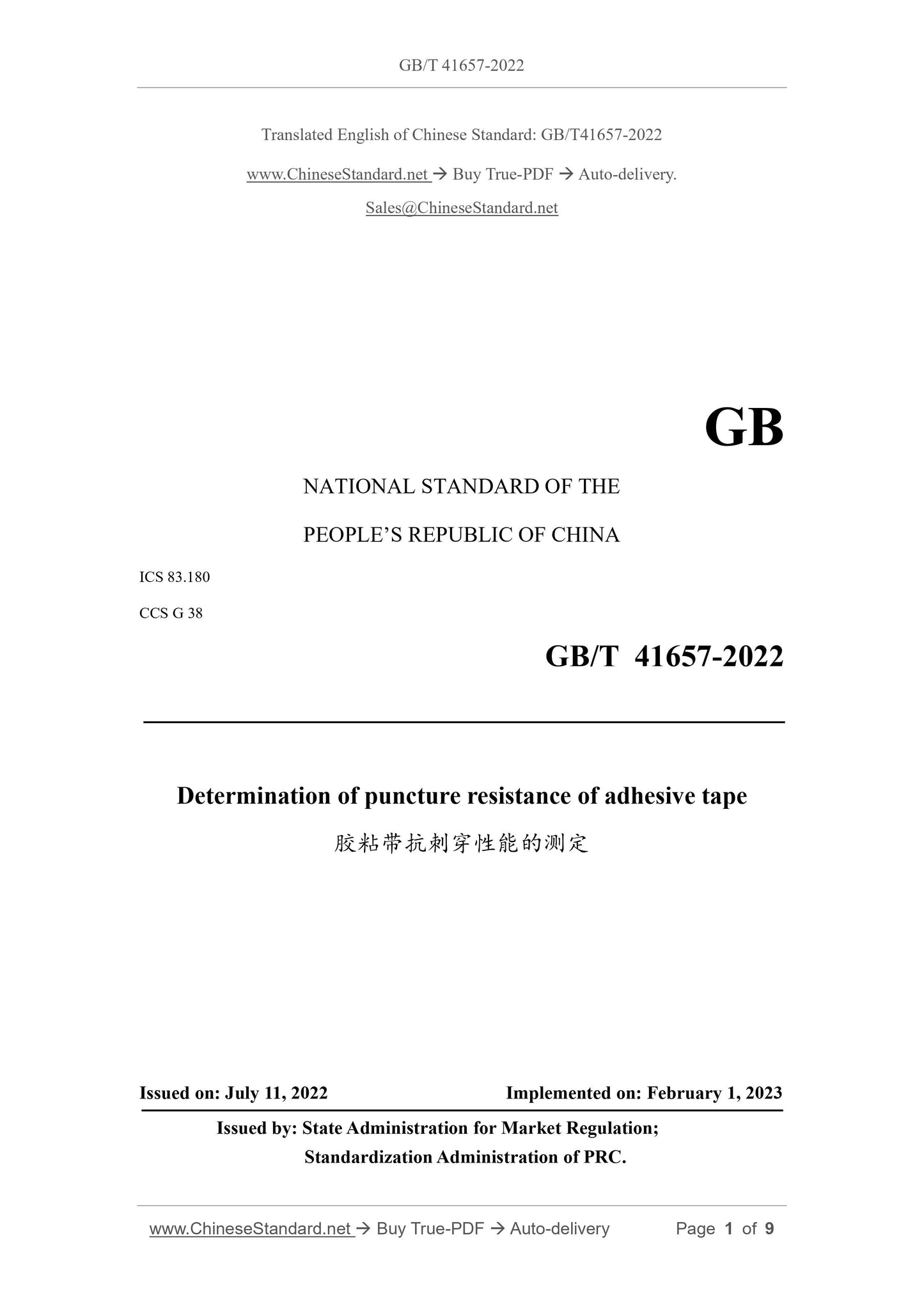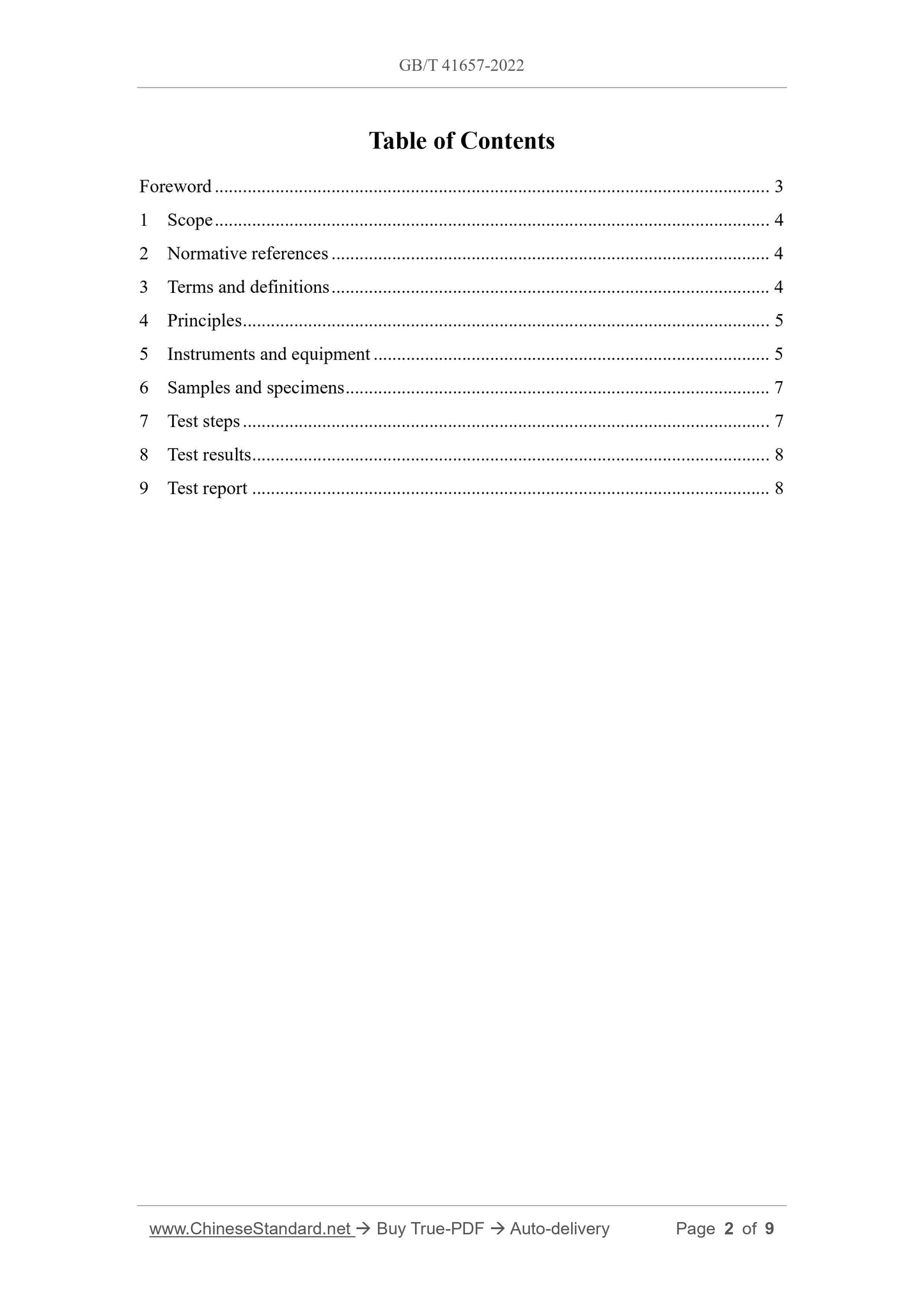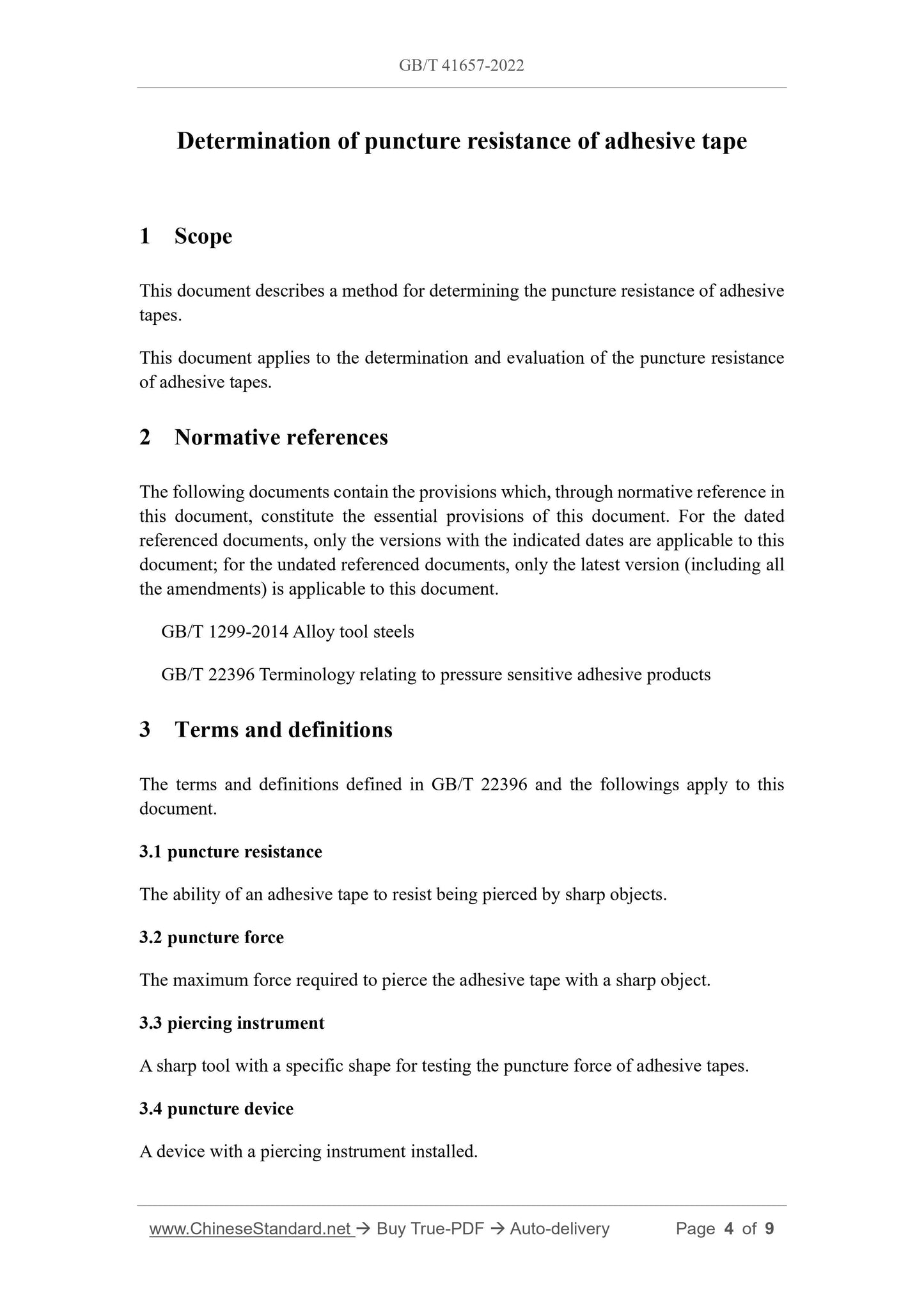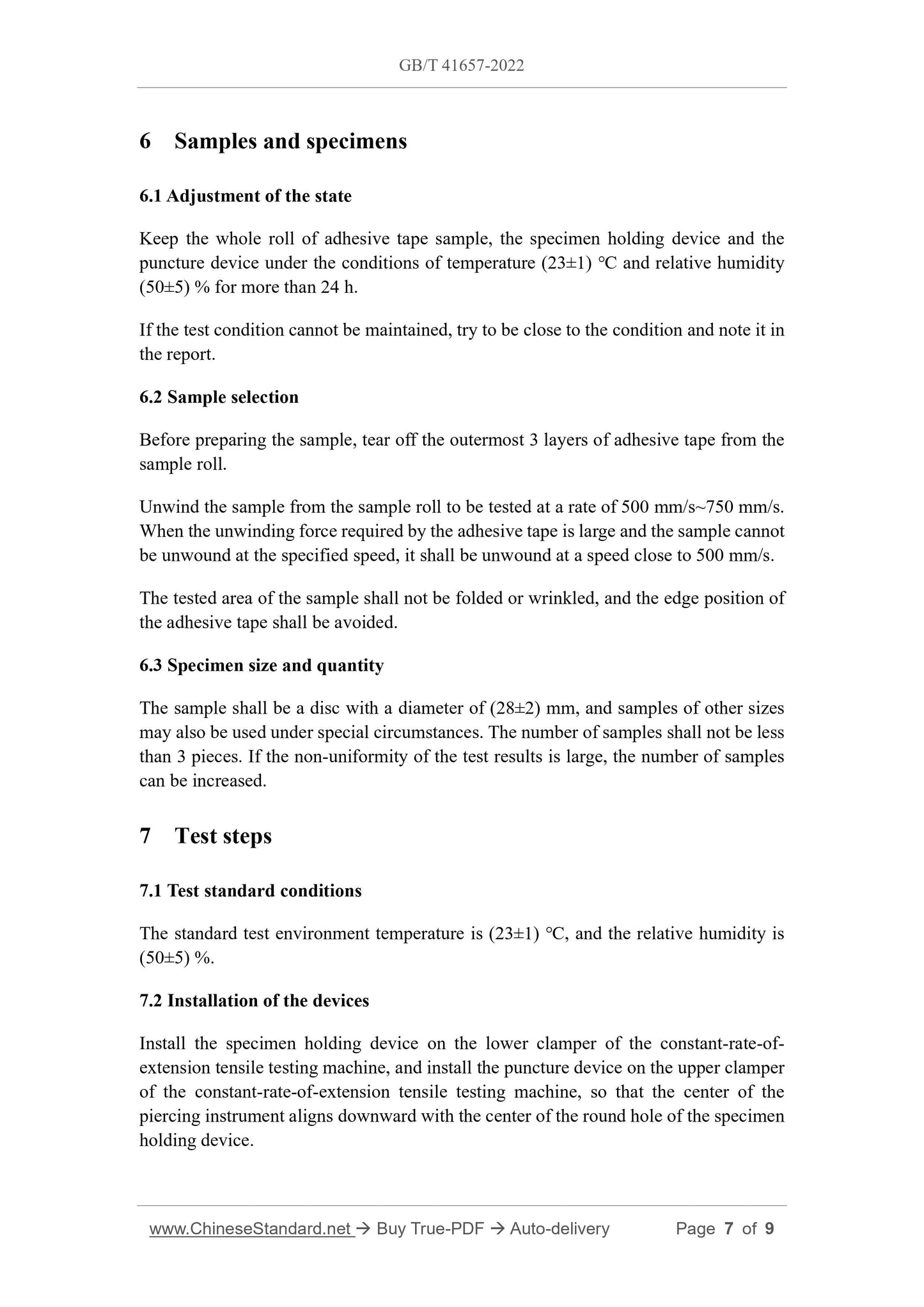1
/
of
5
PayPal, credit cards. Download editable-PDF & invoice in 1 second!
GB/T 41657-2022 English PDF (GBT41657-2022)
GB/T 41657-2022 English PDF (GBT41657-2022)
Regular price
$170.00 USD
Regular price
Sale price
$170.00 USD
Unit price
/
per
Shipping calculated at checkout.
Couldn't load pickup availability
Delivery: 3 seconds. Download true-PDF + Invoice.
Get QUOTATION in 1-minute: Click GB/T 41657-2022
Historical versions: GB/T 41657-2022
Preview True-PDF (Reload/Scroll if blank)
GB/T 41657-2022: Determination of puncture resistance of adhesive tape
GB/T 41657-2022
NATIONAL STANDARD OF THE
PEOPLE’S REPUBLIC OF CHINA
ICS 83.180
CCS G 38
Determination of puncture resistance of adhesive tape
ISSUED ON: JULY 11, 2022
IMPLEMENTED ON: FEBRUARY 1, 2023
Issued by: State Administration for Market Regulation;
Standardization Administration of PRC.
Table of Contents
Foreword ... 3
1 Scope ... 4
2 Normative references ... 4
3 Terms and definitions ... 4
4 Principles ... 5
5 Instruments and equipment ... 5
6 Samples and specimens ... 7
7 Test steps ... 7
8 Test results ... 8
9 Test report ... 8
Determination of puncture resistance of adhesive tape
1 Scope
This document describes a method for determining the puncture resistance of adhesive
tapes.
This document applies to the determination and evaluation of the puncture resistance
of adhesive tapes.
2 Normative references
The following documents contain the provisions which, through normative reference in
this document, constitute the essential provisions of this document. For the dated
referenced documents, only the versions with the indicated dates are applicable to this
document; for the undated referenced documents, only the latest version (including all
the amendments) is applicable to this document.
GB/T 1299-2014 Alloy tool steels
GB/T 22396 Terminology relating to pressure sensitive adhesive products
3 Terms and definitions
The terms and definitions defined in GB/T 22396 and the followings apply to this
document.
3.1 puncture resistance
The ability of an adhesive tape to resist being pierced by sharp objects.
3.2 puncture force
The maximum force required to pierce the adhesive tape with a sharp object.
3.3 piercing instrument
A sharp tool with a specific shape for testing the puncture force of adhesive tapes.
3.4 puncture device
A device with a piercing instrument installed.
6 Samples and specimens
6.1 Adjustment of the state
Keep the whole roll of adhesive tape sample, the specimen holding device and the
puncture device under the conditions of temperature (23±1) ℃ and relative humidity
(50±5) % for more than 24 h.
If the test condition cannot be maintained, try to be close to the condition and note it in
the report.
6.2 Sample selection
Before preparing the sample, tear off the outermost 3 layers of adhesive tape from the
sample roll.
Unwind the sample from the sample roll to be tested at a rate of 500 mm/s~750 mm/s.
When the unwinding force required by the adhesive tape is large and the sample cannot
be unwound at the specified speed, it shall be unwound at a speed close to 500 mm/s.
The tested area of the sample shall not be folded or wrinkled, and the edge position of
the adhesive tape shall be avoided.
6.3 Specimen size and quantity
The sample shall be a disc with a diameter of (28±2) mm, and samples of other sizes
may also be used under special circumstances. The number of samples shall not be less
than 3 pieces. If the non-uniformity of the test results is large, the number of samples
can be increased.
7 Test steps
7.1 Test standard conditions
The standard test environment temperature is (23±1) ℃, and the relative humidity is
(50±5) %.
7.2 Installation of the devices
Install the specimen holding device on the lower clamper of the constant-rate-of-
extension tensile testing machine, and install the puncture device on the upper clamper
of the constant-rate-of-extension tensile testing machine, so that the center of the
piercing instrument aligns downward with the center of the round hole of the specimen
holding device.
7.3 Clamping of the specimen
Under the condition of no tension and wrinkles, place the sample flat on the sample
placing platform of the specimen holding device with the adhesive side facing down,
cover the cover plate, and fasten the fastening screws to ensure that the sample will not
slip horizontally during the test. If the sample is a double-sided adhesive tape, the
adhesive side that is in contact with the puncture device and the adhesive side that is
not in contact with the puncture device shall be marked.
7.4 Determination of the puncture force
Turn on the constant-rate-of-extension tensile testing machine, and set the puncture rate
to 50 mm/min. If the puncture rate is set to other values, it shall be indicated in the test
report. Before each test, reset the force value to zero and then turn on the puncture
device to start the test. The maximum force generated during the test is the puncture
force.
After the test, remove the cover plate of the specimen holding device and observe
whether the sample is punctured and whether a horizontal slip occurs. If the sample
slips in the horizontal direction, the data shall be judged as invalid.
If the sample slips in the horizontal direction during the process of determination, an
annular disc can be added to the sample placing platform of the specimen holding
device, to improve the horizontal friction force of the specimen holding device during
the sample is being punctured and avoid the horizontal slip of the sample.
The annular disc shall be made of a double-sided adhesive tape or a gasket, with an
outer diameter of (28±2) mm and an inner diameter of (10.0±0.5) mm.
8 Test results
The number of samples in each group shall be not less than 3; the test result is expressed
by the arithmetic mean of the puncture force and accurate to 0.1 N; the minimum and
maximum values shall be recorded at the same time. If the sample is not punctured,
record the test result and the measuring range of the testing machine.
9 Test report
The test report shall contain the following information:
a) The number of this document;
b) Sample information;
Get QUOTATION in 1-minute: Click GB/T 41657-2022
Historical versions: GB/T 41657-2022
Preview True-PDF (Reload/Scroll if blank)
GB/T 41657-2022: Determination of puncture resistance of adhesive tape
GB/T 41657-2022
NATIONAL STANDARD OF THE
PEOPLE’S REPUBLIC OF CHINA
ICS 83.180
CCS G 38
Determination of puncture resistance of adhesive tape
ISSUED ON: JULY 11, 2022
IMPLEMENTED ON: FEBRUARY 1, 2023
Issued by: State Administration for Market Regulation;
Standardization Administration of PRC.
Table of Contents
Foreword ... 3
1 Scope ... 4
2 Normative references ... 4
3 Terms and definitions ... 4
4 Principles ... 5
5 Instruments and equipment ... 5
6 Samples and specimens ... 7
7 Test steps ... 7
8 Test results ... 8
9 Test report ... 8
Determination of puncture resistance of adhesive tape
1 Scope
This document describes a method for determining the puncture resistance of adhesive
tapes.
This document applies to the determination and evaluation of the puncture resistance
of adhesive tapes.
2 Normative references
The following documents contain the provisions which, through normative reference in
this document, constitute the essential provisions of this document. For the dated
referenced documents, only the versions with the indicated dates are applicable to this
document; for the undated referenced documents, only the latest version (including all
the amendments) is applicable to this document.
GB/T 1299-2014 Alloy tool steels
GB/T 22396 Terminology relating to pressure sensitive adhesive products
3 Terms and definitions
The terms and definitions defined in GB/T 22396 and the followings apply to this
document.
3.1 puncture resistance
The ability of an adhesive tape to resist being pierced by sharp objects.
3.2 puncture force
The maximum force required to pierce the adhesive tape with a sharp object.
3.3 piercing instrument
A sharp tool with a specific shape for testing the puncture force of adhesive tapes.
3.4 puncture device
A device with a piercing instrument installed.
6 Samples and specimens
6.1 Adjustment of the state
Keep the whole roll of adhesive tape sample, the specimen holding device and the
puncture device under the conditions of temperature (23±1) ℃ and relative humidity
(50±5) % for more than 24 h.
If the test condition cannot be maintained, try to be close to the condition and note it in
the report.
6.2 Sample selection
Before preparing the sample, tear off the outermost 3 layers of adhesive tape from the
sample roll.
Unwind the sample from the sample roll to be tested at a rate of 500 mm/s~750 mm/s.
When the unwinding force required by the adhesive tape is large and the sample cannot
be unwound at the specified speed, it shall be unwound at a speed close to 500 mm/s.
The tested area of the sample shall not be folded or wrinkled, and the edge position of
the adhesive tape shall be avoided.
6.3 Specimen size and quantity
The sample shall be a disc with a diameter of (28±2) mm, and samples of other sizes
may also be used under special circumstances. The number of samples shall not be less
than 3 pieces. If the non-uniformity of the test results is large, the number of samples
can be increased.
7 Test steps
7.1 Test standard conditions
The standard test environment temperature is (23±1) ℃, and the relative humidity is
(50±5) %.
7.2 Installation of the devices
Install the specimen holding device on the lower clamper of the constant-rate-of-
extension tensile testing machine, and install the puncture device on the upper clamper
of the constant-rate-of-extension tensile testing machine, so that the center of the
piercing instrument aligns downward with the center of the round hole of the specimen
holding device.
7.3 Clamping of the specimen
Under the condition of no tension and wrinkles, place the sample flat on the sample
placing platform of the specimen holding device with the adhesive side facing down,
cover the cover plate, and fasten the fastening screws to ensure that the sample will not
slip horizontally during the test. If the sample is a double-sided adhesive tape, the
adhesive side that is in contact with the puncture device and the adhesive side that is
not in contact with the puncture device shall be marked.
7.4 Determination of the puncture force
Turn on the constant-rate-of-extension tensile testing machine, and set the puncture rate
to 50 mm/min. If the puncture rate is set to other values, it shall be indicated in the test
report. Before each test, reset the force value to zero and then turn on the puncture
device to start the test. The maximum force generated during the test is the puncture
force.
After the test, remove the cover plate of the specimen holding device and observe
whether the sample is punctured and whether a horizontal slip occurs. If the sample
slips in the horizontal direction, the data shall be judged as invalid.
If the sample slips in the horizontal direction during the process of determination, an
annular disc can be added to the sample placing platform of the specimen holding
device, to improve the horizontal friction force of the specimen holding device during
the sample is being punctured and avoid the horizontal slip of the sample.
The annular disc shall be made of a double-sided adhesive tape or a gasket, with an
outer diameter of (28±2) mm and an inner diameter of (10.0±0.5) mm.
8 Test results
The number of samples in each group shall be not less than 3; the test result is expressed
by the arithmetic mean of the puncture force and accurate to 0.1 N; the minimum and
maximum values shall be recorded at the same time. If the sample is not punctured,
record the test result and the measuring range of the testing machine.
9 Test report
The test report shall contain the following information:
a) The number of this document;
b) Sample information;
Share










